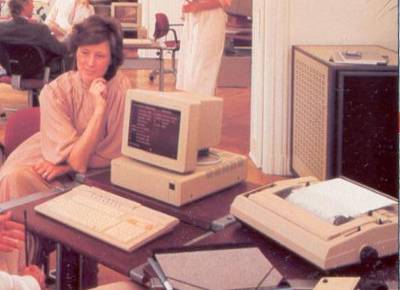Ericsson 9161
This terminal has been made by Ericsson in early 1980s
for Swedish Datasaab E2500. Datasaab E2500 is mainframe system for
business and banks, made since early 1980s. According to "Tema
D21" (Ventzel V. et al, 1994,), in 1983 a D16 mainframe architecture
has been redesigned to E2100 for business and E2500 for bank
applications.
The life of these mainframes was not significantly long as for bank
applications - it was in 1980s, PCs became more popular, yet
introduction of Ericsson's PCs went not as good as they expected. Some
of them survived for some time in bank sector, where if the system works
it is more profitable to keep it running (2019: there is still COBOL and
some branch of dBase used in banking software), but they became replaced
by better Unix solutions. Terminals have been connected to concentrators
using coaxial cable, like in IBM 3270 line, or using twinaxial pair for
larger distances (like IBM 5250) and probably offered similar, if not
larger, capabilities including forms building, simple data processing
for the mainframe and loading of templates. This terminal has some
unusual characteristics. First of all, it is a really high-end as for
1980s. There is a plenty of RAM - 128kB, and it is powered with Motorola
68000 CPU. Yes, 68000, like early Macs or Amiga. The HD68450 DMA
controller is used to maintain memory and devices accessible. Display is
generated with AM8052 controller. We also have a dedicated DRAM
controller and serial port chip which is converted to coaxial or
dual-wire connection and keyboard port. Many PCs of that era were slower
than this terminal.
An unusual thing here is its branding: Inside, it has components from 1981..1983. In front, it's Ericsson (then there were connections of Ericsson with Datasaab). On the rear we also have two more brands: Alfaskop which made Swedish terminals for along time since at least 1970s and also has Ericsson connections, and, surprisingly, Nokia Data. Nokia Data acquired Alfaskop much, much later, Ericsson/Alfaskop/Nokia Data devices became seen around 1987..1988. This is quite strange and device could be serviced for a longer time after acquisition, when the sticker was applied.
| In my unit, the board has been corrected in many places and
numerous times using enameled copper wires. It looks like thee
were some tracks made wrong and corrected and some obvious ones
just not exist (then added with this wire), so it may be an
early revision of board. The board is quite complex, 4-layer
one. The socket for CPU is not stable and CPU may pop out is
device is rotated too much. EPROMs are also in unstable sockets,
secured by small drops of solder. There are also some unusual interfaces used. It looks like the display signals are sent not directly as signals, but using 4 current loops. Additinally with the same connector we have two power voltages and some unnknown signal (maybe sound or video which could not be crammed into current loop?). The keyboard is connected with an own serial port which also carries power for it. |
|
Pinouts
WARNING: My unit is highly modified so it may vary. Also really untested.
Keyboard:

1, 4, 5, 6, 7 - GND
2 - Output from computer (??clock??)
3 - I/O from/to computer (??data??)
8,9 - 5V, fused.
Display - unknown current-loop connector:

1, 2, 14, 15 - Voltage A
4, 17 - Voltage B
5, 10, 12, 13, 16, 18, 23, 25 - N.C.
6, 19 - Output 1
7, 20 - Output 2
8, 21 - Output 3
9, 22 - Output 4
11 - GND
24 - Output???
Voltage A and B are probably monitor power. There is an unregulated few tens of volts between these two leads, about 80V, don't know it is OK or not.
Power supply unit:
=============================
X X X X X X X X X X X . X . X
15 ...
... 1
1 - Voltage A
2, 4 - NC
2 - Voltage B
5,7,9,11,13 - GND
6,8,10,12 - +5V
14, 15 - ?NC? (not conncted to PSU)
Links
http://www.datasaab.se/Bildarkiv/S2500/Miljo/miljo_eng.htm - Datasaab E2500 description






